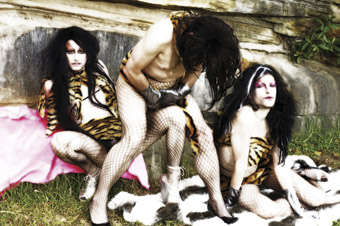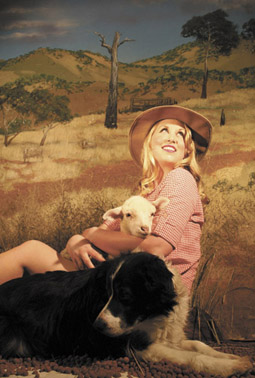indoors and out there
dan mackinlay tests the raunch of CCAS’ oomph

Cave 1, Wild Boys or Bust (2006)
IT’S A TRICKY VENUE, CANBERRA CONTEMPORARY ART SPACE IN GORMAN HOUSE. DESPITE SMOOTH AND SHINY WALLS, THE BUILDING EXUDES THE GHOSTLY TRACES OF SUBURBAN LIVING ROOMS PAST, AND WE MODERN ART CONSUMERS ARE CONDITIONED TO FEEL COMFORTABLE CONTEMPLATING ART IN PLACES AS FAR FROM OUR DAILY EXPERIENCE AS PRACTICABLE. I KEEP EXPECTING TO FIND MY DEPARTED GRANNY KNOTTING CAVADOLI MACRAME IN THE CORNER WHILE SHE MINDS THE EXHIBITION, PAUSING TO CLEAR HER THROAT WHEN I LEAN TOO CLOSE TO THE WORK OR LOOK AT A PAINTING WITH RUDE BITS.
Curator Amita Kirpalini harnesses rather than battles this domestic flavour in Oomph, a parodic survey of raunch culture, the new mediascape’s “bawdy world of boobs and gams” (Ariel Levy, Female Chauvinist Pigs: Women and the Rise of Raunch Culture, Simon & Schuster, 2005). We can expect a little tongue in cheek in such a show, for sure, but the sheer quotidian humdrum which these works sexualise is astounding. The Wild Boys, for example: their slides document a lewd drag music video shoot across a suburban park, abasing and debasing themselves around park benches and Moreton Bay Fig trees. In the hands of our fearless cross-dressing documentarians, the mundane objects that populate public spaces unleash unanticipated lust, fairies of an unlikely sort are lurking at the bottom of the garden, getting off in ways that you never imagined, and they are photographing it to boot. And damn, but these boys can wear a piece of polyester tiger pattern fur to its best conceivable advantage.
Sue Dodd shares the medium of video clips in this show, graciously. With all the breathless seriousness of any YouTube auteur, she has collated a rag tag selection of the icons of pop music and dumped them in an artfully incongruous heap on the gallery floor. The silver body suits, the driving pop beats, the vivid varicoloured backdrop, the diffident backup dancer Ken (is his head in an orange net?)…love it. The text that she intones in each of the three clips summarises a different scandal from a supermarket checkout celebrity magazine, enacted by a cast of celebrity puppets cut out from said gossip mags behind Dodd herself singing. The self-conscious teenage intensity and DIY flavour of it recall punk fanzines, but depict a suburban rebellion directed against no opponent more specific than the eternal vexations of a stardom that its subjects will never possess.
Pilar Mata Dupont and Tarryn Gill have very specific targets in their sights. Their photographs mash up the vocabularies of war propaganda posters and of socialist realism in a pisstake of the soft porn of girlie calendars. The militaristic theme in these images is not subtle: “Join the airforce, see the world before it’s gone” depicts a leggy paratrooper flashing her best patriotic simper for the camera as she descends through smoke machine clouds. This in an Australia where “it’s now more acceptable for…women to appear naked in a magazine than wear the hijab in public” (Gwyn Topham, “A Cultural Paradox Stripped Bare”, Sydney Morning Herald, February 27, 2006). I can hear my Gran’s discrete cough. What is our page four girl media selling us when flogging the anti-introspective eye candy of raunch culture?
I wonder, though, as appropriate as the domestic nature of Gorman House is for this show, is it not domestic enough? This is politically engaged, accessible work, it’s a lot of fun, and there is no reason—the economics of the art world aside—why some of it would not be even more effective if it were displayed somewhere still more public. Dodd’s work is a case in point, being the kind of lo-fidelity material that would weather YouTube with no ill effects. There comes a point where a show that sets out to critique has to justify the manner in which it chooses to do so. Are we sitting smug in the sanitised space of our bourgeois gallery mocking the habits of those others out there in different parts of the cultural landscape?

Isn’t this worth fighting for? (2006) Tarryn Gill and Pilar Mata Dupont
courtesy of the artists
Isn’t this worth fighting for? (2006) Tarryn Gill and Pilar Mata Dupont
If our artists are to be believed, the view from suburbia looking out is a dark one; Alex Martinis Roe invites us to look in at the victims of the objectifying gaze, old-school style. Her piece is a simple site specific video installation trapping a model in the two dimensional confines of the video screen. The captured figure lies in weary resignation, supporting the columns of the gallery with her hands, imprisoned by the photographic process and an unfortunate confusion of dimensionality. It would be a fun bit of visual punning on the role of spectacle in any old gallery space, but it really sets off this show, where our gaze is anything but innocuous. As gallery goers we are media consumers, as much as we are when we’re TV watchers or gossip magazine readers, however much of a pisstake we may make of it.
Oomph, curator Amita Kirpalini, artists Bianca Barling, Sue Dodd, Pilar Mata Dupont & Tarryn Gill, Louise Paramor, Alex Martinis Roe, The Wild Boys; Canberra Contemporary Art Space Gorman House, Feb 16-March 17
RealTime issue #78 April-May 2007 pg. 43






